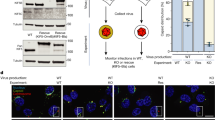Abstract
Varicella-zoster virus (VZV) causes chickenpox and shingles1. Clinical and epidemiological evidence indicates that following an episode of childhood chickenpox (varicella), VZV becomes latent, presumably in dorsal root ganglia, and is reactivated many years later to produce shingles (zoster) in adults2. VZV has been demonstrated in ganglia by electron microscopy and by indirect immunofluorescence3–5, and infectious viral particles have been isolated from acutely infected ganglia of patients who died of disseminated VZV infection6. However, VZV has not been detected in the ganglia of humans without recent exposure to VZV. Tissue culture explant methods that have been successful in the isolation of herpes simplex virus from ganglia have so far failed in the isolation or reactivation of VZV from trigeminal and other dorsal root ganglia7. We describe here the detection of VZV DNA sequences in an acutely infected human sacral ganglion and in normal trigeminal ganglia. These findings support the hypothesis that VZV is latent in normal human ganglia.
This is a preview of subscription content, access via your institution
Access options
Subscribe to this journal
Receive 51 print issues and online access
$199.00 per year
only $3.90 per issue
Buy this article
- Purchase on Springer Link
- Instant access to full article PDF
Prices may be subject to local taxes which are calculated during checkout
Similar content being viewed by others
References
Davis, B. D., Dulbecco, R., Eisen, H. N. & Ginsberg, H. S. Microbiology, 1068 (Harper & Row, Hagerstown, 1980).
Hope-Simpson, R. E. Proc. R. Soc. Med. 58, 9–20 (1965).
Esiri, M. M. & Tomlinson, A. H. J. neural. Sci. 15, 35–48 (1972).
Ghatak, N. R. & Zimmerman, H. M. Archs Path. 95, 411–415 (1973).
Nagashima, K., Nakazawa, M. & Endo, H. Acta neuropath. 33, 105–117 (1975).
Bastian, F. O., Rabson, A. S., Yee, C. L. & Tralka, T. S. Archs Path. 97, 331–332 (1974).
Plotkin, S. A., Stein, S., Snyder, M. & Immesoete, R. Ann. Neurol. 2, 249 (1977).
Ecker, J. R. & Hyman, R. W. Proc. natn. Acad. Sci. U.S.A. 79, 156–160 (1982).
Gilden, D. H., Wroblewska, Z., Kindt, V., Warren, K. G. & Wolinsky, J. S. Archs Virol. 56, 105–117 (1978).
Gilden, D. H. et al. J. virol. Meth. 4, 263–276 (1982).
Gilden, D. H. et al. J. gen. Virol. 60, 371–374 (1982).
Maniatis, T., Fritisch, E. F. & Sambrook, J. Molecular Cloning, A Laboratory Manual, 77–96 (Cold Spring Harbor Laboratory, New York, 1982).
Southern, E. M. J. molec. Biol. 98, 503–517 (1975).
Wahl, G. M., Stern, M. & Stark, G. R. Proc. natn. Acad. Sci. U.S.A. 76, 3683–3687 (1979).
Rigby, P. W. J., Dieckmann, M., Rhodes, C. & Berg, P. J. molec. Biol. 113, 237–251 (1977).
Hyman, R. W., Ecker, J. R. & Tenser, R. B. Lancet ii, 814–816 (1983).
Author information
Authors and Affiliations
Rights and permissions
About this article
Cite this article
Gilden, D., Vafai, A., Shtram, Y. et al. Varicella-zoster virus DNA in human sensory ganglia. Nature 306, 478–480 (1983). https://doi.org/10.1038/306478a0
Received:
Accepted:
Issue Date:
DOI: https://doi.org/10.1038/306478a0
This article is cited by
-
Acute myelitis with multicranial neuritis caused by Varicella zoster virus: a case report
BMC Neurology (2022)
-
Polyneuritis cranialis and vasculopathy caused by varicella zoster virus without rash
Acta Neurologica Belgica (2020)
-
Disseminated zoster in an adult patient with extensive burns: a case report
Virology Journal (2019)
-
A spliced latency-associated VZV transcript maps antisense to the viral transactivator gene 61
Nature Communications (2018)
Comments
By submitting a comment you agree to abide by our Terms and Community Guidelines. If you find something abusive or that does not comply with our terms or guidelines please flag it as inappropriate.



